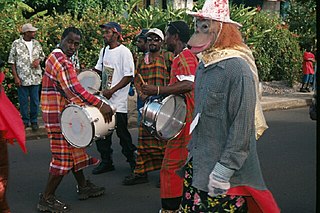
Caribbean music genres are very diverse. They are each synthesis of African, European, Arab, Asian and Indigenous influences, largely created by descendants of African slaves (see Afro-Caribbean music), along with contributions from other communities (such as Indo-Caribbean music). Some of the styles to gain wide popularity outside the Caribbean include, bachata, merengue, palo, mambo, baithak gana, bouyon, cadence-lypso, calypso, soca, chutney, chutney-soca, compas, dancehall, jing ping, parang, pichakaree, punta, ragga, reggae, dembow, reggaeton, salsa, soca and zouk. [1] Caribbean music is also related to Central American and South American music.
Contents
- Antigua and Barbuda
- Benna
- Bahamas
- Barbados
- Belize
- Colombia
- Cuba
- Dominica
- Chanté mas
- Dominican Republic
- Dutch West Indies
- Guadeloupe
- Guyana
- Haiti
- Compas / kompa
- Méringue
- Mizik rasin
- Twoubadou
- Other
- Honduras
- Jamaica
- Martinique
- Puerto Rico
- Saint Kitts and Nevis
- Saint Lucia
- Saint Vincent and the Grenadines
- Suriname
- Trinidad and Tobago
- Calypso
- Cariso
- Chutney
- Soca
- Other 2
- Venezuela
- Virgin Islands
- Careso
- Other 3
- Quelbe
- Yucatán, Mexico
- References
- Further reading
- External links
The history of Caribbean music originates from the history of the Caribbean itself. That history is one of the native land invaded by outsiders; violence, slavery, and even genocide factor in.
Following Christopher Columbus' landing in 1492, Spain laid claim to the entire Caribbean. This claim was met with dissatisfaction from both the natives and Spain's neighbors in Europe; within a few years, bloody battles between the European powers raged across the region. These battles, alongside the various European diseases which accompanied them, decimated the native tribes who inhabited the islands.
Thus the Caribbean was colonized as part of the various European empires. Native cultures were further eroded when the Europeans imported African slaves to work the sugar and coffee plantations on their island colonies. In many cases, native cultures (and native musics) were replaced by those imported from Africa and Europe.
At this point,[ when? ] whatever common Caribbean culture existed was splintered. Each of the European powers had imposed its own culture on the islands they had claimed. In the late 20th century, many Caribbean islands gained independence from colonial rule but the European influences can still be heard in the music of each subtly different culture.
Island-specific culture also informs the music of the Caribbean. Every island has its distinct musical styles, all inspired, to one degree or another, by the music brought over from the African slaves. As such, most Caribbean music, however unique to its own island culture, includes elements of African music - heavy use of percussion, complex rhythmic patterns, and call-and-response vocals. In many cases, the difference between one style and another comes down to the rhythms utilized in each music; every island has its own rhythmic sensibilities.
The complex deep origins of Caribbean music are best understood with a knowledge of Western Hemisphere colonial immigration patterns, human trafficking patterns, the resulting melting pot of people each of its nations and territories, and thus resulting influx of original musical influences. Colonial Caribbean ancestors were predominantly from West Africa, West Europe and India. In the 20th and 21st centuries immigrants have also come from Taiwan, China, Indonesia/Java and the Middle East. Neighboring Latin American and North American (particularly hip hop and pop music) countries have also naturally influenced Caribbean culture and vice versa. While there are musical commonalities among Caribbean nations and territories, the variation in immigration patterns and colonial hegemony tend to parallel the variations in musical influence. Language barriers (Spanish, Portuguese, English, Hindustani, Tamil, Telugu, Arabic, Chinese, Hebrew, Yiddish, Yoruba, African languages, Indian languages, Amerindian languages, French, Indonesian, Javanese and Dutch) are one of the strongest influences.
Divisions between Caribbean music genres are not always well-defined, because many of these genres share common relations, instrumentation and have influenced each other in many ways and directions. [2] For example, the Jamaican mento style has a long history of conflation with Trinidadian calypso. [3] Elements of calypso have come to be used in mento, and vice versa, while their origins lie in the Caribbean culture, each uniquely characterized by influences from the Shango and Shouters religions of Trinidad and the Kumina spiritual tradition of Jamaica. [4] Music from the Spanish-speaking areas of the Caribbean are classified as tropical music in the Latin music industry.



